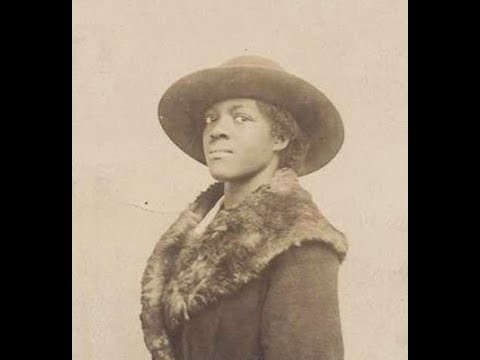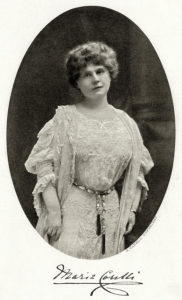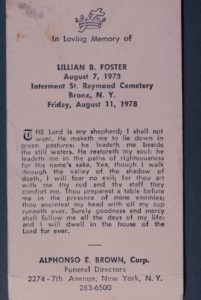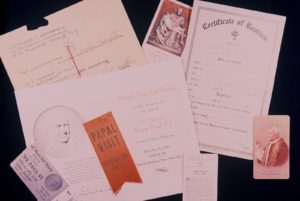No Crystal Stair – Mabel Hampton’s Long Climb Home
“Life for me ain’t been no crystal stair.” – From Mother to Son by Langston Hughes
Mabel Hampton was a dancer during the Harlem Renaissance, a domestic worker, and an early lesbian activist. In her later years, she worked with the Lesbian Herstory Archives to preserve LGBT black history. Hampton appeared in the films, “Silent Pioneers” and “Before Stonewall.” The Lesbian Herstory Archives has an extensive collection of taped reminiscences of her life, photos, personal papers, and her 1950s lesbian paperbacks.
In 1984 Hampton addressed the crowds at the New York City Pride Parade: “I, Mabel Hampton, have been a lesbian all my life, for 82 years, and I am proud of myself and my people. I would like all my people to be free in this country and all over the world, my gay people and my black people.” In 1985 she was named Grand Marshal of the Pride Parade. I marched in both of those parades. Gay Pride Parades in the 1980s had a festive spirit – marchers felt safe and empowered in the presence of thousands of other lesbians and gays. The marchers were also serious – we wanted the same civil rights as other Americans. Before the New York City Council passed the “gay civil rights” bill on March 20, 1986, we had no legal protection from discrimination in housing, employment, and public accommodations.
Most marchers were white, and spectators who lined the streets uptown were also white—friends and tourists. Downtown, much closer to the Village, spectators were primarily gay, and many of them were black, Hispanic with a handful of Asians. They didn’t march because to be spotted in the parade would have “outed” them, and if that happened their family would mostly likely have disowned them. They did not want to risk giving up their families.
Catholic marchers also enjoyed a special protest unit of our own co-religionists. Members of the Blue Army of Mary and other ultra conservative Catholics would throw holy water and shake rosaries as we walked by. Many of these scolds were women. I’m not sure what they intended to accomplish by throwing holy water on the marchers—an exorcism or miracle. The splash of water was refreshing on a hot, humid June day even though it was thrown in hate and disgust. But we also knew that it was their substitute for spit.
Reflecting on Mabel Hampton now, almost 40 years later and when I am much closer to her age at that time, I can only marvel, appreciate and respect what she had to endure to persevere as a proud black woman who was lesbian and a Catholic. 
A poem my father, Eugene Doherty, liked to use in his creative writing classes was “Mother to Son” by Langston Hughes. It was written in 1922. The subject of the poem was a strong woman who had experienced poverty and setbacks but continued to strive and move forward. She encourages her son to do the same. I’m sure Dad had his own mother in mind; but I immediately thought of Mabel Hampton.
Life for me ain’t been no crystal stair.
It’s had tacks in it,
And splinters,
And boards torn up,
And places with no carpet on the floor—
Bare.
But all the time
I’se been a-climbin’ on,
And reachin’ landin’s,
And turnin’ corners,
And sometimes goin’ in the dark
Where there ain’t been no light.
So boy, don’t you turn back.
Don’t you set down on the steps
’Cause you finds it’s kinder hard.
Don’t you fall now—
For I’se still goin,’ honey,
I’se still climbin,’
And life for me ain’t been no crystal stair.
Mabel Hampton was born on May 2, 1902 in Winston-Salem, North Carolina. Her mother died when she was a baby. She went to live with her grandmother, but after she died, Mabel was sent to live with an aunt and uncle in New York. She was seven. They treated her harshly and she was raped by the uncle. After that, Mabel decided to run away. “I went out with nothing but a dress, a jumper dress, and I walked and walked.” She was found at a playground by Bessie White, who took her into her home. Hampton lived in the White household until Bessie died. At 17 she was on her own. Arrested for prostitution, she served a two-year sentence at the Bedford Hills, NY reformatory. Hampton said she was falsely accused because she attended women’s parties.
After she was released from jail, she began life as a dancer and singer with an all-black women’s troupe on Coney Island in Brooklyn, NY. She met an older woman who introduced her to the word, “lesbian.” The two had one night together before the woman had to return to her husband in Philadelphia. “She taught me some things,” Hampton said. “I knew some of them, but she taught me the rest.”
From Coney Island, Mabel moved to bigger and more glamorous stages in Harlem. The 1920s were the time of the Harlem Renaissance, and Mabel met and partied with many black lesbian and gay notables, including Jackie “Moms” Mabley, Ethel Waters, Gladys Bentley, Ethel Williams and socialite A’Lelia Walker. “I had so many girlfriends it wasn’t funny,” Hampton recalled. 
While waiting for a bus, Hampton met a woman she described as “dressed like a duchess.” Her name was Lillian Foster, and the two met on September 22, 1932. Foster recalled the meeting decades later: “Forty-four years ago I met Mabel. We was a wonderful pair. I’ll never forget it…We haven’t been separated since in our whole life. Death will separate us. Other than that I don’t want it to end.” They referred to themselves as Mabel and Lillian Hampton and made their home at 639 E. 169th Street in the Morrisania neighborhood in the Bronx. Depending on the circumstance, they sometimes called themselves “sisters.”
After Hampton left dancing, she began cleaning homes for wealthy white families. It was during this time that she met Joan Nestle, the daughter of one of these families, who co-founded the Lesbian Herstory Archives in New York City in 1974. She volunteered for the organization, and her stories of the wild parties of the Harlem Renaissance were enjoyed by the other volunteers. Her memories and experiences contributed to the knowledge of the lives of black lesbians in the early 20th century.
In 1935, when she was 33 years old, Mabel Hampton was received into the Roman Catholic Church. She was baptized at St. Thomas the Apostle Church on West 118th Street in Manhattan, a church with a sizable congregation of black Catholics. The Lesbian Herstory Archives website stated, “It was a step in her ongoing quest for spiritual comfort, and included a lifelong devotion to the mysteries of the Rosicrucian, and a full collection of the writings of Marie Corelli, a Victorian novelist with a spiritual bent.”
There is no information at all on why Hampton decided to become a Catholic, what it meant to her, or how she reconciled her committed relationship with Lillian Foster with her faith. Obviously, she did, like thousands of other Catholic lesbians. A photograph of a collage of Hampton’s Catholic memorabilia includes prayer cards of friends or people she knew from the 1960s, her baptismal certificate, and membership in St. Augustine Catholic Church in the Bronx. She attended Pope Paul VI’s Mass in Yankee Stadium on October 4, 1965. Even if she was not a practicing Catholic at the end of her life, those papers were important to her as part of her life’s story.
I have thought a lot about who or what might have led Mabel Hampton to seek out baptism. Maybe she met a Catholic woman or a couple at one of the rent or dance parties she attended. Maybe she was curious and walked into a church and met a black sister who listened and answered some of her questions. Hampton’s life provides some clues. She strove for justice. She persevered. She was humble. She loved deeply. She shared. These qualities can be founded in anyone but are strengthened and reinforced in a person by faith. She also had the example of Bessie White, who rescued a child from the street and abuse and fed, clothed and cared for her.
The fact that Mabel Hampton was interested in Rosicrucian mysteries and the writings of Marie Corelli provides a few clues to her spirituality and spiritual interests.
A modern Rosicrucian group – The Ancient Mystical Order Roase Crucis (AMORC) was founded in New York City in 1915 by H. Spencer Lewis (1883–1939). Claiming that he had learned the teachings of the order from European Rosicrucians, Lewis attracted new members by distributing his teachings in mail-order lessons and pamphlets. Rosicrucians are concerned with the occult, astrology, and esoteric secrets.
Hampton’s collection of Marie Corelli’s books provides another hint of Hampton’s interest in mysticism and the supernatural. Marie Corelli, born Mary Mackay (1855-1924) was a popular novelist and Queen Victoria’s favorite author. A reoccurring theme in Corelli’s books is her attempt to reconcile Christianity with reincarnation, astral projection, spirit or time travel, and the occult. She was associated with a Rosicrucian organization. 
For over 40 years, Corelli lived with her companion, Bertha Vyver, and left everything to her when she died. She never identified herself as a lesbian, but frequent erotic depictions of female beauty appear in her novels.
Mabel Hampton died of pneumonia on October 26, 1989. She was 87 years old. She is buried in St. Raymond’s Cemetery in the Bronx, New York. Her life partner and wife, Lillian Foster, is also buried in St. Raymond’s.
I am very grateful to Joan Nestle, Deborah Edel and other volunteers from the Lesbian Herstory Archives for preserving and honoring the generous life of Mabel Hampton. She is an inspiration to the lesbians who follow in her footsteps. 

